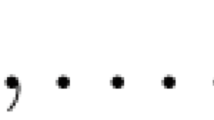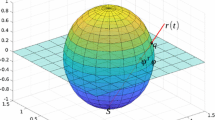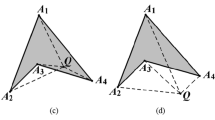Abstract
Objects with fixed orientations play an important role in many application areas, for instance VLSI design. Problems involving only rectilinearly oriented (rectangular) objects, as a simplest case, have been studied with the VLSI design application in mind. These objects can be transistors, cells or macros. In reality, they are more suitably represented by polygons rather than just rectangles. In this note we describe how to perform a general decomposition of a set of polygons with fixed orientations in order to solve various computational geometry problems which are important in VLSI design. The decomposition is very simple and efficiently computable, and it allows the subsequent application of algorithms for the rectilinear case, leading to some very efficient and some optimal solutions. We illustrate the technique in detail at the problem of finding the connected components of a set of polygons, for which we derive an optimal solution. The wide applicability of the method is then demonstrated at the problem of finding all pairs of intersecting polygons, yielding an optimal solution.
Zusammenfassung
Geometrische Objekte, die durch Geradenstücke mit wenigen, festgelegten Orientierungen begrenzt sind, spielen in vielen Anwendungsbereichen eine wichtige Rolle, so etwa beim Entwurf höchstintegrierter Schaltkreise (VLSI). Probleme, die nur Rechtecke betreffen, sind als ein einfachster Fall wegen ihrer Bedeutung beim VLSI-Entwurf bereits untersucht worden. Die Rechtecke repräsentieren Transistoren, Zellen, oder großere Funktionseinheiten. Eine wirklichkeitsgetreuere Repräsentation hierfür sind jedoch Polygone. In der vorliegenden Arbeit beschreiben wir ein allgemeines Verfahren zur Zerlegung einer Menge von Polygonen mit festen Orientierungen mit dem Ziel, beim VLSI-Entwurf wichtige Probleme der algorithmischen Geometrie zu lösen. Die Zerlegung ist sehr einfach und kann schnell berechnet werden; sie erlaubt die anschließende Lösung, von Problemen mit Hilfe von Algorithmen für rechteckige Objekte. Dieser Ansatz führt zu einigen effizienten und einigen optimalen Algorithmen. Wir illustrieren diese Technik im einzelnen am, Problem, die Zusammenhangskomponenten einer Menge von Polygonen zu bestimmen; wir beschreiben eine optimale Lösung dieses Problems. Dann zeigen wir die breite Anwendbarkeit des Verfahrens und leiten exemplarisch eine Lösung des Problems ab, alle Paare sich schneidender Polygone zu bestimmen.
Similar content being viewed by others
References
Aho, A. V., Hopcroft, J. E., Ullman, J. D.: The Design and Analysis of Computer Algorithms. Reading, MA: Addison-Wesley 1974.
Bentley, J. L., Wood, D.: An optimal worst case algorithm for reporting intersections of rectangles. IEEE. Trans. Comp.C-29, 571–577 (1980).
Edelsbrunner, H.: Intersection problems in computational geometry. Institut für Informationsverarbeitung, Graz, Austria, Report F93, 1982.
Edelsbrunner, H., van Leeuwen, J., Ottmann, Th., Wood, D.: Computing the connected components of simple rectilinear geometrical objects in D-space. RAIRO Theoretical Informatics18, 171–183 (1984).
Guibas, L., Saxe, J.: Solution to <problem 80-15>. Journal of Algorithms4, 177–181 (1983).
Güting, R. H.: Conquering contours: efficient algorithms for computational geometry. Universität Dortmund, Federal Republic of Germany, 1983.
Güting, R. H.: Stabbing c-oriented polygons. Information Processing Letters16, 35–40 (1983).
Güting, R. H.: Dynamic c-oriented polygonal intersection searching. Report No. 175, Universität Dortmund, Federal Republic of Germany, 1984.
Hertel, S., Mehlhorn, K.: Fast triangulation of simple polygons. Proceedings of the 1983 International Foundations of Computation Theory Conference. Lecture Notes in Computer Science158, 207–218 (1983).
Lee, D. T., Preparata, F. P.: Computational geometry: a survey. IEEE Trans. Comp.C-33 1072–1101 (1984).
McCreight, E. M.: Efficient algorithms for enumerating intersecting intervals and rectangles. Xerox PARC Research Report CSL-80-9, 1980.
Nievergelt, J., Preparata, F. P.: Plane-sweep algorithms for intersecting geometric figures. Comm. ACM25, 739–747 (1982).
Ottmann, Th., Widmayer, P.: Solving visibility problems by using skeleton structures. 11th Symposium on Math. Foundations on Comp. Science, Prague, Lecture Notes in Computer Science176, 459–470 (1984).
Shamos, M.: Computational geometry. Dept. of Comp. Science, Yale University, New Haven, CT, 1978.
Vaishnavi, V. K., Wood, D.: Rectilinear line, segment intersection, layered segment trees, and dynamization. Journal of Algorithms3, 160–176 (1982).
van Leeuwen, J., Wood, D.: The measure problem for rectangular ranges in d-space. Journal of Algorithms2, 282–300 (1981).
Widmayer, P., Wu, Y. F., Wong, C. K.: Distance problems in computational geometry for fixed orientations. ACM SIGGRAPH Symposium on Computational Geometry. Baltimore, MD, 1985, 186–195.
Author information
Authors and Affiliations
Additional information
The work of this author was partially supported by the National Science Foundation under Grants MCS 8342682 and ECS 8340031. This work was performed while this author was a summer visitor at the IBM T. J. Watson Research Center.
Rights and permissions
About this article
Cite this article
Widmayer, P., Wu, Y.F., Schlag, M.D.F. et al. On some union and intersection problems for polygons with fixed orientations. Computing 36, 183–197 (1986). https://doi.org/10.1007/BF02240065
Received:
Revised:
Issue Date:
DOI: https://doi.org/10.1007/BF02240065




